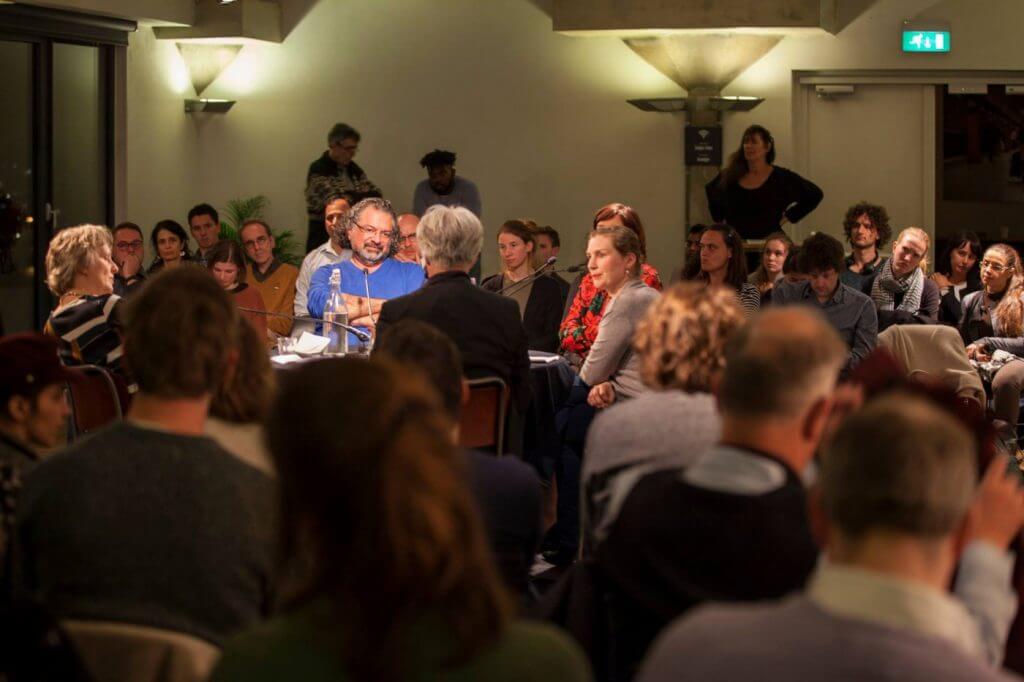On the 14th and 15th of March Netwerk Democratie organized the Dutch edition of the EUCROWD conference as part of the international European Citizen Crowdsourcing project in which Netwerk Democratie collaborates with seven European partners to investigate the possibilities for a crowdsourcing pilot on EU level.

The conference was divided into two parts. A public discussion among experts on the general need for new strategies of citizen participation and an afternoon session presenting the lessons learned from national and international crowdsourcing initiatives as well as a brainstorm with participants on recommendations for an EU level crowdsourcing pilot.
Tuesday 14th: Who’s Afraid of the People?
The conference started off with a roundtable discussion at Pakhuis de Zwijger. About 60 people attended the conversation with guest speaker Hille Hinsberg from Estonia and co-organizer of The People’s Assembly; Firoez Azarhoosh community builder and co-founder of the Meevaart in Amsterdam; Dick Pels, political commentator and writer; and Godelieve van Heteren, director of Europa Arena and president of the Europese Beweging Nederand.
Central issues in the discussion were the position of ‘the People’ in current politics and possible strategies for truly democratic forms of political participation. In light of the rise in populist politics Dick Pels, writer of the book ‘The People do not exist’, warned that we should not take democracy too literal in the sense that the people, the demos, should rule, because it enables populists to argue that they are the real democrats and everybody else is the elite. While according to Pels an elected elite is something that is necessary in order to do politics. It however matters what kind of notion of politics you apply. Firoez Azarhoosh offered an alternative interpretations of politics. According to him “politicians are interpreting their roles falsely, because politics is not just the political system, it is daily life: the way of living we choose for.” Politics should therefore be a continuous conversation about our day-to-day experiences and not just about voting once in four years.
According to Godelieve van Heteren we should recognise this mismatch between the institutions that are there to organise our society and the experience of day-to-day life that is rapidly changing. Next to recognising it, we should also dare to adjust our institutions. The story of Hille Hinsberg offered an example of how the urgency for change can take shape. In Estonia people became activated and angry after a scandal about anonymous financial donations to political parties. As a result civic activists with support of the president and various stakeholders set up The People’s Assembly in which via an online and offline deliberation process new legislation about political parties was crowdsourced. The final agreed set of proposals was send to Parliament and three new laws have been accepted among which official support for public petitions that reach 1,000 signatures.
For the first time people actively questioned what kind of procedures are to be tolerated in political parties, how are they elected, how transparent is this, what are the usual participatory procedures outside of election periods, and how should they be organised? –Hille Hinsberg
Another problem that was identified during the discussion is the role of the majority in our current political systems. A prime example is Brexit in which half of the population decided for the other half of the population. An important conclusion is that democracy should never silence the minority. We thus need to think about new ways to organise the interaction between citizens and the political institutions and politicians who represent us. Most important for these new methods for legitimate decision-making is that they are not based on majority vote, but adhere to a set of democratic principles. With the help of the audience the following principles for democratic processes were crowdsourced: consensus, trust, information, transparency, openness and inclusivity, tolerance, diversity, acceptance of failure, stubbornness, and equal voting
No matter what kind of method or digital channels are used, these principles should take central stage. Secondly we should acknowledge and foster changing power structures in which power is not only in politics and the elite, but is dispersed through society. This means a development towards polycentric local nests of power. As Elisa Lironi from ECAS added we cannot expect everybody to participate in democracy, but we can design participation channels in such a way that everyone who want to participate can do so. Adhering to principles like inclusiveness, informed participation and transparency is essential to make these channels of participation a democratic success.
Wednesday 15th: Crowdsourcing a new European democracy
The next day we went deeper into digital democracy and the European context. Four case presentations offered a diverse perspective on the current developments in e-participation.
Elisa Lironi, Digital democracy Manager at ECAS introduced the current state of e-participation in the EU and the necessity for crowdsourcing. An already existing example is the European Citizen Initiative (ECI), which offers citizens the opportunity to propose an issue for the European agenda. The ECI however proved quite powerless, because of the high barriers for usage. These are for example: the not user friendly technology, the difficulty of gathering a million signatures, but also the very low guarantee for actual impact on European legislation. Important questions for a better participation tool are therefore what kind of technology should be used and where in the political process should crowdsourcing take place?
Hille Hinsberg, e-governance expert at PRAXIS, explained that the People’s Assembly in Estonia was built out of 5 phases. Starting with an online crowdsourcing of proposals and comments, offline analysis of the web context, impact assessment by experts, stakeholder deliberation on the main 5 issues, and a grass-root deliberation with 314 participants selected by sortition. For the legitimacy of the crowdsourcing process transparency and openness played a crucial role. All proposals, feedback and decision-making was made public and explained. Communication via the media thus played a vital role.
Paul Isaris, software developer at Science for You (SciFY), presented the tool ‘DemocracIT’. This tool has been developed to strengthen public consultations in Greece. On DemocracIT citizens can comment on legislation proposals they are interested in. The gathered input of citizens is summarized and visualized in such a way that policy makers can easily merge the comments in the final law proposal. Citizens should however also be able to review how much of their comments are eventually used in the final law in order to reach effective participation
May-Britt Jansen, Program Manger at municipality of Amsterdam and Jeroen van Berkel, Member of the Executive Committee at municipality of Amsterdam illustrated the use of e-participation in Amsterdam-West. The tools they develop and use are always located at the intersection between the processes and projects within the municipality and the interests and needs of citizens in the neighborhood. The newly launched open source tool ‘Stem van West’, for example, enables citizens to propose and discuss their ideas for improving the neighborhood and present the best idea during the city council meeting. For citizens it has proved important that the tool is custom made for them and for politicians it is important that the e-participation is not a burden but fits into their work process.
World Café
In the second half of the afternoon small groups rotated in three rounds over four questions presented by the following table hosts:
-
- Anthony Zacharzewski, director Democratic Society (U.K.), hosted the question ‘What topics and policies should be crowdsourced at EU level?’
- Godelieve van Heteren, director Europa Arena, hosted the question ‘Where in the political process should crowdsourcing take place?’
- Paul Isaris, software developer at SciFY, hosted the question ‘What technology should be used in a crowdsourcing tool at the EU level?’
- Maarten de Groot and Kimberley Beijersbergen, European Student Forum and the European Citizen Initiative ‘More than Education’, hosted the question ‘How can we strengthen youth participation in the EU?’
Some criteria for a crowdsourcing process at EU level that were offered are:
> Before crowdsourcing there should be a clear conception of the desired impact on both policy and trust between people and politics
>There should be political support from Members of European parliament
> Issue focused participation could trigger involvement of non-typical stakeholders such as youth
> It should be visible for users how they are benefitting from the crowdsourcing process. There should be some kind of feedback loop.
> The used tool should be accessible for everybody, for example by working with different steps in the participation process.
> European crowdsourcing should function in a decentralized manner, with a local look and feel.
> Open source technology can persuade citizens that their data is secure and private.
On the input gathered in the World Café Netwerk Democratie will write a report that together with the reports from our seven partners will form an advice on a crowdsourcing pilot for the EU. In February 2018 this advice will be presented in the final event in Brussel.



